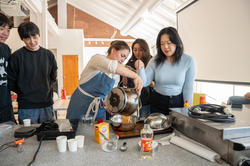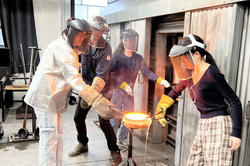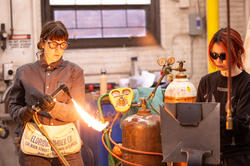Taught by alum Erica Pernice, the class uses material exploration and iteration to examine how design fits in a culinary landscape.
RISD Grad Students Explore the Connection Between Glass and Alchemy
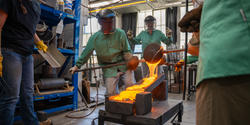
Students in a graduate-level Glass studio led by professor Rachel Berwick 84 GL are conducting hands-on research as they explore the combined histories of alchemy and glass. By studying practical, theoretical and historical texts and collecting materials such as sea shells and mica during field trips to Conanicut Island and elsewhere, the class is becoming familiar with the material properties of various substrates and using them to pursue research aligned with their studio practices.
On a fall afternoon in the hot shop, Berwick led the class through a glass casting project mixing the found materials with glass. “The point of this experimentation is to give students the opportunity to think about how they can use heat and molten material to explore transformation,” Berwick says.
Two students used ladles to scoop molten glass heated up to 2,400 degrees Farenheit from the kiln, while another stirred in the materials they had selected. They then poured the liquid mixture onto angled graphite blocks so they could observe its movement and response to the heat.
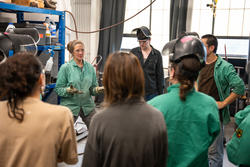
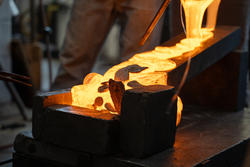
Different materials react in different ways. Mica, for example, is compatible with glass so it doesn’t crack, but it also becomes reflective. “Mixing it with the glass creates this fascinating surface,” Berwick notes. “Sometimes it’s gold in color, and sometimes it’s silver.”
Each student is conducting in-depth material investigations and demonstrating them weekly in preparation for a comprehensive end-of-semester presentation. Berwick says one student has discovered Chinese medicinal recipes that she’s folding into her investigations of wood and glass. Another is researching alchemical recipes for recreating gems such as emeralds and pearls.
“A student majoring in Industrial Design, for example, is going to use the information they gather in the hot shop very differently from the way a student majoring in Glass would approach it,” Berwick explains. “I encourage each student to focus on whatever piques their curiosity.”

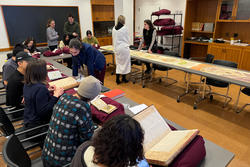
Learning to translate the things they encounter in the hot shop and through off-campus adventures into prompts for their own studio work is important. Each field trip takes the students to a place where they see manifestations of alchemy through a different lens. A visit to the University of Rhode Island’s Marine Lava Collection inspired grad student Lingyi Hu MFA 26 GL to experiment with recipes that alter the clarity and transparency of the glass.
A trip to a rare books library with manuscripts over 300 years old turned up recipes that Landscape Architecture student Tanmayee More MLA 25 is using to incorporate coastal materials such as sand, sea shells, marsh grass and hardwoods into glass.
“As the students become more comfortable conducting research, they’re also becoming more confident as artists,” Berwick adds. “And alchemy, or transformation, is at the heart of that process.”
Kaylee Pugliese
October 30, 2024
